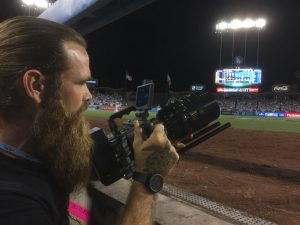Cinematic Lenses Are Increasingly Deployed for Big-Event Coverage
Anamorphic lenses enhance the storytelling aspects of sports production
Story Highlights
The coming together of traditional TV-production techniques and traditional cinematic techniques continues. Increasingly, sports-production professionals are turning to tools that historically were the purview of big-screen cinema. The latest to make the move? Tom Wells, director of photography and owner, Technician Films, who has been part of the World Series on Fox for nine years and finds himself increasingly working with things like anamorphic lenses to tell the story of a sports event in new ways.

The use of cinematic lenses gives sports coverage and profile pieces a more emotional and dramatic look.
“When we started, we were shooting standard player interviews before the Series starts, chopping up the interviews for the next week,” he says. “Now we are shooting ENG with the camera of the moment to capture cinematic slo-mo footage from the sidelines that can be used interstitially.”
The images become part of the in-game bumpers, vignettes, and features seen throughout the broadcast.
“In those moments,” Wells explains, “our goal is to take the viewer from the technicals of the game itself and into the human and emotional side of it. We are gathering those elements constantly, and we have only a few seconds here and there, so what can we do to separate those moments from the broadcast in a way that enhances the broadcast?”
One method is to use cinema-grade cameras and lenses, including Arri Alexa and RED cameras coupled with Cooke Optics anamorphic lenses. The use of anamorphic lenses has been enabled by improvements in the conversion of anamorphic material to the 16:9 aspect ratio required for broadcast.
“Previously,” says Wells, “it was difficult to integrate large-format cameras into the broadcast quickly because of the large file sizes associated with them and allocating the time needed to recrop and adjust the images was just about impossible. But we collaborated on the workflow with the editors and can now shoot widescreen to further enhance the cinematic and theatrical feel.”

Tom Wells has embraced using Cooke anamorphic lenses to bring a new look to live sports coverage.
Technology aside, another important enabler was that MLB opened up prime spots in the dugouts and field access that allows the photographers to capture reaction shots and game play from a truly “up close and personal” perspective.
“[Creative and technical consulting agency] Thumbwar manages the internal media, and they tap into the fiber lines after we have determined our locations at the ballpark and then run a fiber drop to that location with a card reader,” says Wells. “Throughout the game, we pull cards and feed moments of excitement back to the compound. The card reader on the field mounts directly to the edit systems, and, within three minutes, footage is downloaded, and the media manager is scrolling through shots and pulling selects.”
An in-game editor works with an assistant director to cut as many as five bumps during the game. A features editor and an associate producer, meanwhile, will be cutting images for the next game. And a third editor will cut a rollout for the end of the game.
“All three are pulling down the game and creating content in real time,” notes Wells.
According to Mike Davis, SVP, field and technical operations, Fox Sports, the use of cinema lenses coupled with postproduction techniques can help improve storytelling by adding emotion.
“There are a lot of different things you can do to add emotion to what you’re shooting,” he says, “and you use these lenses to bring film techniques to enhance that and bring out the emotion.” On Thursday Night Football, for example, the material can be accessed by EVS for super-quick turnaround.
“Back in the day,” Davis adds, “you would shoot something during the first half and then use it later and have to think back. The unit is really a film unit that is looking for different things than the guys on the main cameras [look for]. They have a lot more freedom to hunt around for things with an artistic eye that isn’t just one more coverage camera. They have a totally different perspective.”
The use of lenses from Cooke Optics helps: even in the cinema world, they offer a different look.
“The equipment helps,” Davies notes, “and the Cooke lenses really made for an artistic impression, but it is the team behind it.”
Wells and his team have been on a technology evolution for eight or nine years. And, although cutting-edge systems like 8K cameras that can capture the whole field and allow for cutouts have yet to find a solid application, the anamorphic lenses from a company that has been part of nearly every Best Picture Oscar winner from the earliest days of cinema are now making a real difference.
“Cooke goes back to the ’20s and silent films and was the first with a faster lens that was needed when film developed sound,” says Wells. “They have a distinct look to them, a cinematic, theatrical look that adds a little bit more drama because they are anamorphic lenses.”
When it comes to knowing the difference between an image captured with an anamorphic lens and one shot with a spherical lens, Wells says there are two groups: image nerds like him, who pick shots apart from a technical perspective, and others, who see the footage and simply respond to it emotionally. The anamorphic effect separates the player or object of interest from a background in a unique way and allows shallow depth of field to be taken to a new level.
“We can isolate our point of interest from the rest of the world,” he explains. “We collaborated with producers to try out the Cooke lenses, and, when they saw the first shots, they said, ‘Why would we shoot on anything else?’”
Combined with the traditional broadcast Canon and Fujinon glass that dominates regular game coverage, the Cooke lenses create an imaging package that delivers the best of all worlds: storytelling images that show what is happening with ultimate clarity and emotional images that raise the connection of the viewer to those game-action images.
“It’s the same desired effect you see in every feature film,” says Wells.
One thing that changes for Wells and the team is the number of frames being shot. Everything is knocked back down to 24 frames per second (fps) for editing, but a person walking may be shot at 60 fps, and, for someone sliding into home plate, it may be 120 or even 200 fps.
“You need to capture moments like eyes closing, and they happen so quickly,” says Wells. “The in-game cameras are shooting wide and being safe as they capture the action of the play, but we intentionally get the camera on the ground and look for unique perspectives that don’t always work for normal game coverage.”
The goal, ultimately, is to capture images that not only document the event but create and heighten emotion the way images found in cinema do.
“Broadcast moves quick, but, in film, you take the time to construct a shot: for example, maybe a shadow rakes across a face to signify a change in emotion, or perhaps a light in the background turns off at a specific time, and that adds a layer of language to the image that means something to the viewer,” he says. “Cinema is a visual story that, with subtle nuances, makes the viewer feel something without understanding why. Simply put, it’s using of a bunch of psychological techniques to influence the viewer’s mind to feel what it is the filmmaker wants you to feel.”
Bringing those techniques to a sports event means focusing on facial expressions, such as the elation after a home run or the intensity while walking to home plate. And having dugout access means that the shooters are on hand to capture all the reactions and emotions.
“You use shallow depth of field to isolate the player. You don’t want to see the scoreboard, just the face of the player,” says Wells. “And you have only a few seconds or even just a few frames to convey that, so larger-sensor cameras with cinematic anamorphic lenses take those moments to a different level.”
Davies says that, with audiences becoming accustomed to cinematic cutaways, the production team can bend the rules to be even more artistic. Editors that can handle RAW video files and add in things like speed ramping and color effects are changing the visual language of sports production.
“They have a heck of a lot more ability to manipulate the image,” he adds, “and the workflows are getting faster.”
